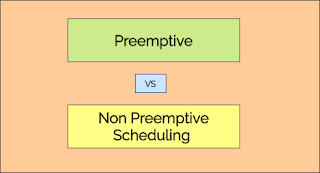In the dynamic realm of computer science and operating systems, scheduling algorithms play a pivotal role in optimizing system performance. Among these algorithms, two prominent contenders stand out: Preemptive Scheduling and Non-Preemptive Scheduling. In this comprehensive exploration, we delve into the nuances of each, unraveling their intricacies to provide an insightful understanding for tech enthusiasts and professionals alike.
Understanding Preemptive Scheduling
Preemptive Scheduling operates on the principle of time slicing, where tasks are allocated specific time slots, and the system can interrupt and switch between tasks dynamically. This method ensures a fair distribution of resources, preventing any single process from monopolizing the CPU.
Advantages of Preemptive Scheduling
Responsive System: The preemptive approach enables quick responsiveness to high-priority tasks, enhancing system agility.
Effective Multitasking: Multiple tasks can run concurrently, promoting efficient multitasking capabilities.
Real-time Processing: Well-suited for real-time systems where timely task execution is critical.
Challenges of Preemptive Scheduling
Overhead: The constant switching between tasks incurs a slight overhead due to context switching.
Complexity: Implementing preemptive scheduling demands more intricate coding to manage task interruptions.
Unveiling Non-Preemptive Scheduling
Contrastingly, Non-Preemptive Scheduling adheres to a sequential execution model, allowing a process to run uninterruptedly until completion. The system switches between tasks only when a task concludes or voluntarily relinquishes control.
Advantages of Non-Preemptive Scheduling
Simplicity: The non-preemptive model is simpler to implement, requiring less complex coding.
Predictable Execution: Task execution is predictable, as interruptions occur only at task completion.
Limitations of Non-Preemptive Scheduling
Limited Responsiveness: In scenarios requiring swift responses to changing priorities, non-preemptive scheduling may fall short.
Inefficient Resource Utilization: The system may face underutilization if a high-priority task is in progress, blocking others from execution.
Choosing the Right Scheduling Strategy
Now, the question arises: which scheduling strategy is optimal for a given scenario? The answer lies in understanding the specific requirements and nature of the system or application.
Scenarios Favoring Preemptive Scheduling
Real-Time Systems: Applications demanding instantaneous response times benefit from the agility of preemptive scheduling.
Dynamic Environments: Environments with frequently changing priorities find preemptive scheduling advantageous.
Scenarios Favoring Non-Preemptive Scheduling
Simple Systems: In less complex systems, non-preemptive scheduling may suffice, offering ease of implementation.
Predictable Workloads: When task predictability is crucial, non-preemptive scheduling proves beneficial.
Key Difference Between Preemptive and Non-Preemptive Scheduling
Preemptive Scheduling |
Non Preemptive Scheduling |
|---|---|
| Process is interrupted in the middle of execution | Process is not interrupted in the middle of execution |
| CPU is allocated to the processes for the limited time | CPU is allocated to the process till it terminates |
| Waiting time and Turnaround time is less. | Waiting time and Turnaround time is more |
| It is flexible | It is rigid |
| High priority process frequently arrives in the ready queue, low priority process may starve | Process with less CPU burst time may starve when long burst time process is in execution |
| It is cost associated | It is not cost associated |
| It has overheads of scheduling the processes. | It does not have overheads. |
| Time slicing with dynamic task switching | Sequential execution until task completion |
| Swift response to high-priority tasks | May lack responsiveness in dynamic scenarios |
| Allows efficient multitasking | Suitable for less complex systems |
| Well-suited for real-time systems | May not be optimal for real-time requirements |
| Requires intricate coding for task interruptions | Simple implementation, less coding complexity |
| Less predictable due to dynamic task switching | Ensures predictable execution until task completion |
| May incur overhead due to constant switching | Efficient utilization in stable workloads |
| Adaptable to frequently changing priorities | May struggle in highly dynamic scenarios |
| May introduce complexity in coding | Preferred for simplicity in less complex systems |
| Real-time systems, dynamic environments | Less complex systems, predictable workloads |
| Efficient handling but with some overhead | Task interruptions are minimal, if any |
| Enhanced responsiveness with some overhead | Stability with potential underutilization |
| Depends on the need for agility and responsiveness | Depends on the simplicity and predictability required |
| More intricate coding for dynamic task management | Simpler implementation with fewer coding challenges |
| Optimized for scenarios requiring quick task switching | Optimal for stable workloads and sequential processing |
| Example: Priority, SRTF etc | Example: FCFS, SJF etc |
FAQs: Unraveling Common Queries
1. How does Preemptive Scheduling enhance responsiveness in a system?
Answer: Preemptive Scheduling achieves enhanced responsiveness by dynamically switching between tasks, ensuring high-priority processes are addressed promptly.
2. Is Non-Preemptive Scheduling suitable for complex systems?
Answer: Non-Preemptive Scheduling's simplicity makes it suitable for less complex systems where intricate task switching is unnecessary.
3. Can Preemptive Scheduling handle real-time processing efficiently?
Answer: Yes, Preemptive Scheduling is well-suited for real-time systems, ensuring timely task execution in dynamic environments.
4. What challenges come with Non-Preemptive Scheduling's limited responsiveness?
Answer: Non-Preemptive Scheduling may struggle in scenarios requiring swift responses to changing priorities, potentially leading to inefficiencies.
5. How does Preemptive Scheduling cope with the complexity of task interruptions?
Answer: While Preemptive Scheduling introduces some coding complexity for managing task interruptions, the benefits in responsiveness often outweigh this challenge.
6. In what situations does Non-Preemptive Scheduling prove advantageous for resource utilization?
Answer: Non-Preemptive Scheduling shines in situations with predictable workloads, ensuring efficient resource utilization without constant task interruptions.
Conclusion: Striking the Balance
In conclusion, the choice between preemptive and non-preemptive scheduling hinges on the unique requirements of the system. Each approach presents its set of advantages and limitations, influencing its suitability for different contexts.
As the digital landscape evolves, understanding these scheduling strategies becomes paramount for system architects and developers. This nuanced comprehension empowers them to make informed decisions, optimizing system performance based on the specific demands of their projects.

Post a Comment